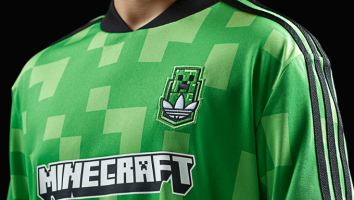Video game properties are emerging as a new power-player in consumer products, and licensees around the world are lining up to get plugged in.
CP programs inspired by video games are nothing new—just ask Super Mario—but a raft of recent blockbuster hits has put the gaming industry in the spotlight as properties like Overwatch, Minecraft and Fortnite ink deals on an almost daily basis. In the span of a few weeks this summer, Epic Games signed licensing agreements for its Fortnite franchise with Florida-based toyco Jazwares (toys), New Jersey-based retailers Spirit Halloween and Spencer’s (costumes, accessories), Arizona’s McFarlane Toys (toys), Washington’s Funko (collectibles) and Australia’s Moose Toys (collectibles).
Fortnite: Battle Royale launched on Microsoft Windows, macOS, PlayStation 4 and Xbox One in September 2017 before making its iOS debut in April. The game drops 100 players onto an island, where they can fight it out in a battle royale or team up to defeat a horde of monsters. Since its launch, the game has grown into a bona fide phenomenon.
“Fortnite has obviously captured the zeitgeist in a huge way,” says Mat Piscatella, executive director of games for market research firm The NPD Group. He likens it to World of Warcraft, Guitar Hero and Minecraft in terms of cultural impact. In fact, a recent report from New York research firm SuperData found that if Fortnite’s sales were removed from Q2 2018 console revenue, there would be a 6% drop compared to the same period last year (Fortnite crossed the US$1-billion revenue mark in July).
“We’re now seeing an influx of players, and particularly younger folks, getting into gaming because of Fortnite,” says Piscatella. “It’s changing so much about the business model and how we think about players’ relationships to the game and to each other. Fortnite is crossing [every] barrier between gaming and pop culture.”
According to Piscatella, games that launched 10 or even five years ago were expected to be hot for a few weeks until the next temporary hit emerged—think racing games with only a handful of tracks, or beat-em-up titles with nothing left beyond the final boss. Recent entrants, however, have focused on franchise-building in an effort to achieve long-term sustainability.
“We’re seeing an overall trend in the space where these games are lasting for months and years, rather than just a few weeks,” Piscatella says. “I’m sure part of the motivation for these licensing arrangements—particularly on long-lead products like toys—is because games like Fortnite should be around for four or five years, or maybe even longer. There’s more confidence these games will still be in the market when the products hit shelves.”
Tim Kilpin, president and CEO of California-based Activision Blizzard Consumer Products Group, says gaming properties are growing into some of the most powerful franchises around.
“These properties have the potential to have as much reach, if not more, as traditional film and TV,” Kilpin says. He points to Overwatch, which draws millions of players daily, each of whom spend an average of two hours playing. “That’s the equivalentof a feature film every day,” he says.
In May, Activision Blizzard’s consumer products group signed a raft of agreements for the Overwatch brand. Hasbro was named master toy licensee, while NERF, LEGO Group, Funko and Scholastic were also tapped to create consumer products inspired by the game. Additionally, retailer UNIQLO inked a deal that will see a number of Activision Blizzard properties—including Overwatch—feature in an exclusive apparel line.
“We’re just scratching the surface in terms of where we think we can go with these things,” Kilpin says.
Press play
Jazwares has been playing in the video game space for decades, creating consumer products inspired by properties like Mega Man, Sonic, Minecraft, Roblox and Fortnite. The toyco’s recent agreement with Epic Games will see it launch Fornite-inspired figures, playsets, weapons, tools, plush, vehicles, loot boxes and environments in December.
Building out a significant consumer products program is a crucial step in creating a video game franchise, says Sam Ferguson, VP of global licensing for Jazwares. “If you do your licensing correctly, it will drive back to the game.”
Last year, Jazwares partnered with user-generated social gaming platform Roblox to launch a toy line inspired by some of the social gaming platform’s most popular games and characters. Each toy includes a code that users can redeem for a reward through the platform, driving further engagement. The codes also introduce Roblox to consumers who buy the toys simply because they look cool.
“When we entered into licensing at the beginning of 2017, it was a test to see how content and characters born out of [UGC] would resonate,” says Tami Bhaumik, VP of marketing and community safety at Roblox. She says the product range has been doing well with fans, and Roblox reports that the redemption rate on the virtual codes attached to Jazwares’ toy range is close to 40% (according to the company, the industry average is closer to 15%).
Roblox’s business development and developer relations teams both played a part in deciding what characters and games from the social gaming platform would be spotlighted by Jazwares’ toy range.
“Diversity was a major part of the criteria in our selection process,” Bhaumik says. “That includes making sure we’re representing the genders correctly, making sure we have styles that appeal to different age groups, and that we’re not excluding any of our audience.”
Data was another significant piece of the puzzle. According to Ferguson, insights from Roblox on the most popular avatars, the most downloaded items and the most played games was critical in building out Jazwares’ toy range. In fact, he argues that the monthly active users benchmark has become just as important as the box-office results. “With these digital guys, they’ve got data coming out of their ears,” Ferguson says.
Since launching toys with Jazwares, Roblox has partnered with BioWorld on apparel and announced publishing agreements with Egmont (international) and HarperCollins (North America).
From a digital brand standpoint, Ferguson says the publishing deal is significant because it’s a touch point parents (and industry executives) can understand and trust. But as important as consumer products are to building a video game property into a full-on franchise, the journey from digital to physical can be a tricky one.
“The truth is there will be some super-successful video games that just don’t translate to consumer products,” says John Friend, head of Halo and Xbox consumer products for Microsoft’s 343 Industries. “In some games, you’re the hero. If it’s a first-person experience and you don’t often see [the characters you’re playing on screen], that can be hard to translate into consumer products. In most successful entertainment-based consumer products programs, there’s this idea that you love the hero and want to become part of their world.”
Friend says the world of Halo has been built out through lore explained in the games and trailers to ensure players can relate to and engage with the franchise across all touch points, from action figures to apparel. In fact, fans have taken it upon themselves to dissect and expand on the franchise’s characters and storylines in countless online articles and YouTube videos. This is crucial, Friend says, to translate the time and effort users expend in-game through the various brand extensions.
“When you look at overall engagement with games, the number of hours kids spend in games and in-game universes dwarfs what they’re doing with other entertainment mediums,” he says. “The average Halo user on a monthly basis spends anywhere from 20 to 40 hours playing the game.”
Level up

Competitive gaming creates opportunities for team-specific consumer products and also drives engagement back to gaming properties
In the past, Ferguson believes the industry wrote video games off as being niche. “What’s interesting is that it’s a big, multi-billion-dollar niche,” he says. “Now, I think people realize this ‘niche’ is comparable to—if not bigger than—the movie business. But unlike a movie franchise, where everything is geared toward a [release] window and it’s an event-driven business, the player base for video game properties is constantly engaging.”
NPD’s Piscatella says the social aspect of gaming has been a major contributor to gains in engagement. In the past, he argues, kids were limited to playing with friends and neighbors in close proximity, and with those who shared the same console and equipment.
“Now, with Fortnite, you can be on mobile and your friend can be on PC and someone else can be on Nintendo Switch, and you can still all play together and communicate,” Piscatella says. “Because it’s so much easier, it’s becoming a lifestyle. People aren’t just playing; they’re also watching and talking about it. It’s as much a social hangout as it is video game playing.”
Friend agrees that increasing engagement is something of a cheat code for the gaming industry’s success. Recent research from UK-based market intelligence company The Insights People found that 94% of UK kids ages four to 18 actively do other things while in front of the telly. While it’s easy to be distracted when watching TV, it’s more difficult when gaming, he says.
Gaming, by its nature, requires active participation (“If you’re in a game with your friends and not present, they’re not going to be happy,” Friend says), which makes the experience more engaging overall.
And thanks to all of that franchise-building, kids can now engage with gaming properties at every moment of the day through various touch points including consumer products, streaming platforms like YouTube and Twitch, and competitive gaming, says Activision Blizzard’s Kilpin. There are even professional competitive leagues popping up around these games. For example, Activision Blizzard’s The Overwatch League currently includes 12 teams from the US, the UK, South Korea and China. In July, the London Spitfire team emerged as champions of the inaugural League season, taking home a US$1-million grand prize.
Fans watch streaming and competitive gaming not just to see their favorite players duke it out, but also to learn how to play better (ultimately driving engagement back to the game itself), Kilpin adds. Because of this, Activision Blizzard is not only taking advantage of traditional consumer products inspired by the franchise—think toys, apparel and publishing inspired by the games’ characters and storylines—but also of the competitive league and its teams, he says.
“When two teams are playing against each other in the Overwatch League, the characters in the game are dressed up in team colors. That’s a whole new look, a whole new reason to collect the characters,” Kilpin says. “I also think you’ll see us start to expand to the traditional sports merchandise of jerseys, hats and trading cards. We’re just getting started.”
Game on
As gaming franchises continue to grow, Jazwares’ Ferguson says those franchises need to be seamless across every activation point.
“Users don’t want to have to start a new account or lose their XP [experience points]. They understand that the game might be more snackable on mobile compared to the more immersive play available on a console, but ultimately they want to play with the avatar that they’ve spent ages building. That’s really important, especially for downloadable content.”
When a product comes with a redemption code—like Jazwares’ Roblox range—Ferguson says it’s crucial that those rewards can be unlocked in the game whether users interact through a mobile device, a console or a PC.
Friend believes that seamless transition will soon lead gamers into even more immersive experiences. Microsoft recently partnered with the restaurant and entertainment company Dave & Buster’s to launch the Halo: Fireteam Raven arcade game. The four-player experience is played on a 130-inch screen with four mounted weapons, which allows players to physically immerse themselves in the world of the game.

Microsoft is launching location-based brand extensions for its Halo franchise, including an arcade game at Dave & Buster’s.
“When you play the arcade game, you pull up your Halo account, scan in and we’ve got leader boards online that show what you’ve done in-game. Over time, you can imagine that the things you do in this arcade game are part of your career record in the bigger Halo game.”
Moving forward, Friend says he is closely monitoring location-based virtual reality experiences that can more seamlessly interact with the real world. His dream, he says, is that one day the Halo franchise will have its own version of Universal Parks & Resorts’ The Wizarding World of Harry Potter.
“How amazing would it be to walk into the Halo universe and actually be there with your friends? Then you start to think about those experiences and how they could connect back to your game persona. I think we’re going to be able to experiment and create things people haven’t seen before,” Friend says.
He also believes customization will go hand-in-hand with these immersive experiences, allowing players to broadcast their in-game accomplishments—whether they are achieved through traditional gaming or location-based extensions—in the outside world.
“I think personalization and customization as a theme is a really interesting one, and something I don’t know that we’ve executed perfectly yet. If I accomplish something in the game that I’m proud of, how can I bring that into the physical world? If I want to put on a jersey, so to speak, how can I make that accomplishment part of my jersey when I’m out in the ‘real world?’ It’s an interesting challenge, and manufacturing technologies are evolving too,” Friend says.
“It’s an amazing time to be in the gaming industry, and at the nexus of gaming and consumer products. There’s a wave building and it hasn’t come close to cresting yet.



























